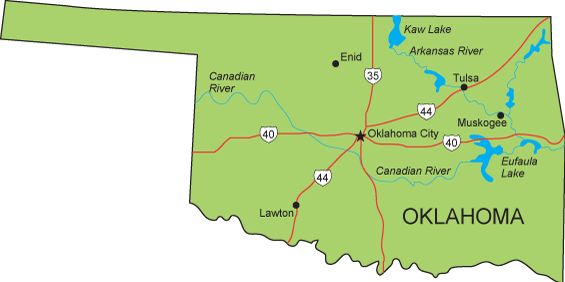Oklahoma is a state in the South Central portion of the United States that is both historic and diverse. Known for its Native American past and role in the westward expansion, Oklahoma's history is convoluted but compelling; its past has been shaped by the Trail of Tears, Land Runs, and settlement booms. Today, Oklahoma is an energy-producing powerhouse; it is also an agricultural leader and a burgeoning aerospace state. Oklahoma showcases a rural flavor next to urban advancement.
Oklahoma City and Tulsa are major economic drivers of the Oklahoma economy; the education system in Oklahoma is also a draw, with excellent public universities and career tech organizations. Oklahoma is geographically diverse, with flat plains in the West and rugged hills in the East, but such geographical diversity is complemented by the resilient spirit and strong traditions of the state of Oklahoma.
Check Out: All About New Mexico: Check History, Map, Economy and Education
What is the Capital of Oklahoma?
Oklahoma City is the capital of Oklahoma, the biggest city in the state, and a prominent center for major political, cultural, and commercial activities. It was established as the capital in 1910, and it is the home to all of the state’s government, the governor's office, and legislative powers.
The city is known for its government role, but it is also a center for energy, especially oil and natural gas. The city combines history and growth, boasting history and culture with some museums, a lively downtown, and important memorials. As the capital city of Oklahoma, it is the heart of the state's economy, leadership, and identity.
Flag of Oklahoma
![Oklahoma - US Flags [dot] Design](https://usflags.design/assets/images/flag-oklahoma-1925-1941.jpg)
The flag was adopted in the Design in 1925, and it has been slightly modified since, with the most recent change occurring in 1941. The flag consists of a field of sky blue, representing faithfulness and devotion.
In the center of the flag is a buffalo-skin shield that belongs to an Osage warrior, which includes six golden crosses that symbolize lofty principles. Then crossed over the shield is a calumet (peace pipe) and an olive branch to signify peace and unity between cultures.
This flag honors traditions of Native American cultures while also exemplifying the enduring spirit of the state of Oklahoma's culture of peace.
What is the Geography of Oklahoma?

Source: StateMaps
Oklahoma is situated in the South Central U.S., and is bordered to the south by Texas; to the north by Kansas; to the northeast by Missouri; to the east by Arkansas; and to the northwest and southwest by Colorado and New Mexico, respectively.
Oklahoma is a state with a wide-ranging geography. Oklahoma is comprised of a blend of plains, forests, mountains, and rivers. The geography of Oklahoma rises dramatically from east to west. Eastern Oklahoma is characterized by rolling hills and woodlands, while western Oklahoma contains flat grasslands and wide open prairies.
What is the History of Oklahoma?
Oklahoma's origins are closely intertwined with Native American experience and the westward expansion of the United States. Before first contact with Europeans, American Indians, like the Wichita, Caddo, and Plains Apache, lived in this region.
In the 1830s, due to the Federal Indian Removal Act, many Native American nations, such as the Cherokee, Chickasaw, Choctaw, Creek, and Seminole, were forcibly removed from their homelands in the southeastern United States to Oklahoma, which was called “Indian Territory.”
All of this changed in the late 19th Century when the U.S. government officially opened portions of this land again to not Native settlers during a series of land runs (the most famous land run occurred in 1889).
When non-Native settlers once again flooded into Oklahoma, the population grew at an incredible pace, and the economy grew, as well. Finally, on November 16, 1907, Oklahoma officially became the 46th state in the United States, merging Oklahoma Territory and Indian Territory.
Education in Oklahoma
The Oklahoma State Department of Education is responsible for the administration of education in Oklahoma. The education system consists of public education (K-12), career and technology education (CTE), and post-secondary education (higher education).
Oklahoma supports major public universities, the University of Oklahoma (OU) in Norman and Oklahoma State University (OSU) in Stillwater, with excellent programs for academic, research, and athletic strength. The Oklahoma CareerTech system provides technical and vocational education for high school students and adult learners to support workforce demands.
Economy of Oklahoma
Oklahoma's economy is quite diverse and is strongly based on many of the state's traditional economic drivers: energy, agriculture, manufacturing, and aerospace. Oklahoma became economically significant during the early 20th century when oil was discovered and developed, resulting in cities like Tulsa being known as "The Oil Capital of the World."
Currently, the oil and natural gas industries still greatly impact the state’s economy, with Oklahoma ranked amongst the top energy-producing states in the U.S.
Agriculture comprises a second tier of economic achievement, with Oklahoma being one of the nation’s top producers of beef, wheat, poultry, and cotton. Oklahoma also has a burgeoning aerospace and defense industry presence, with military bases and defense contracts with companies like Boeing and Northrop Grumman.
Comments
All Comments (0)
Join the conversation